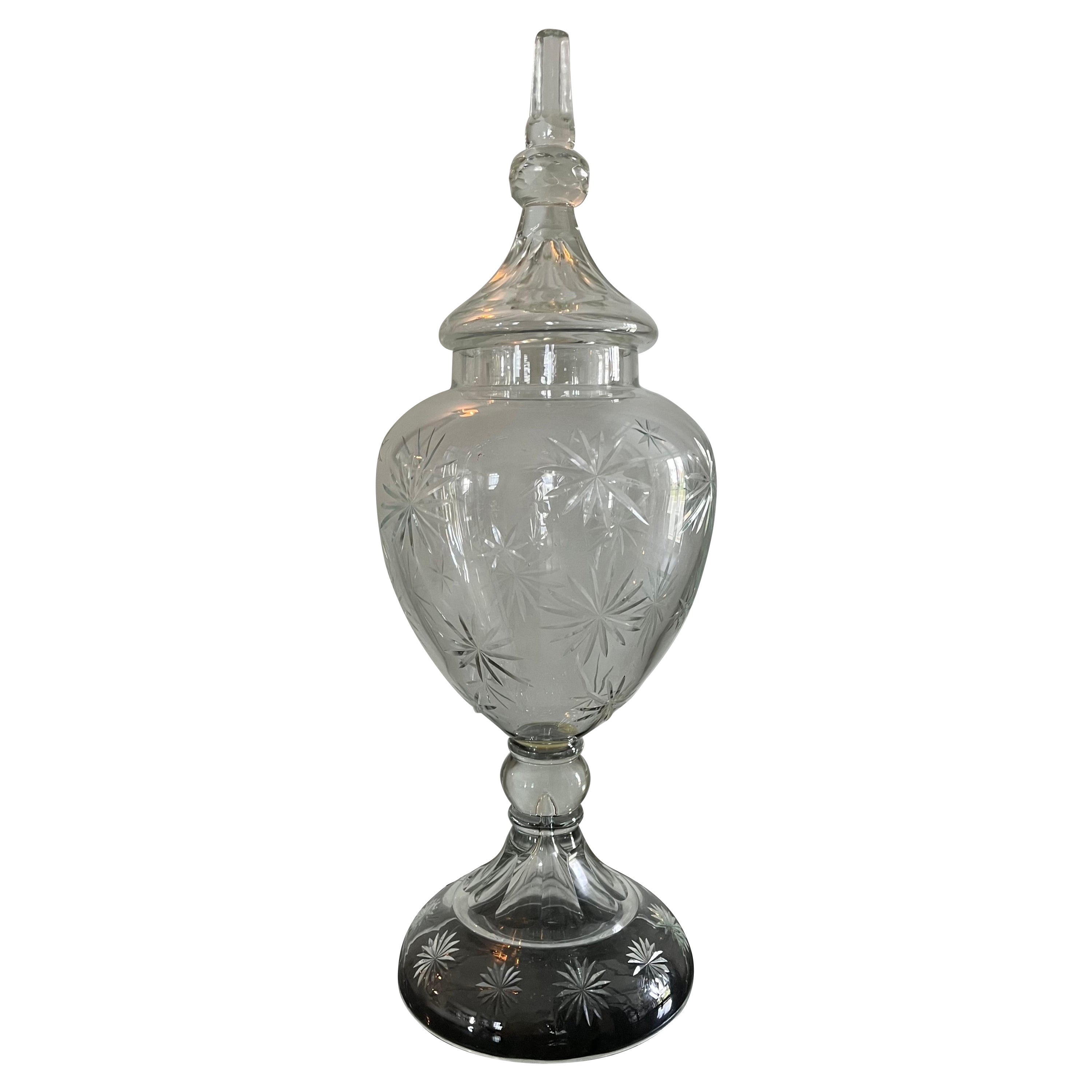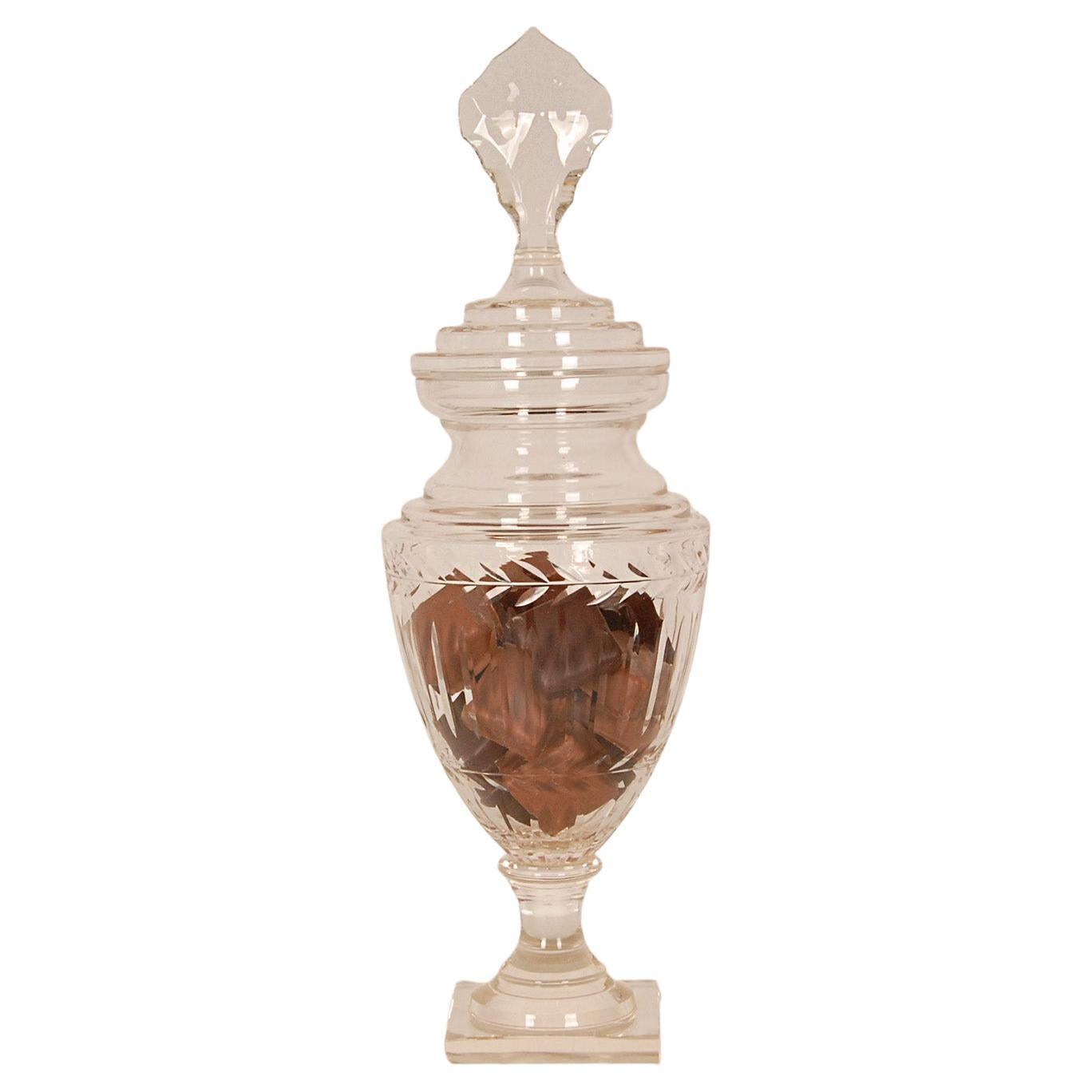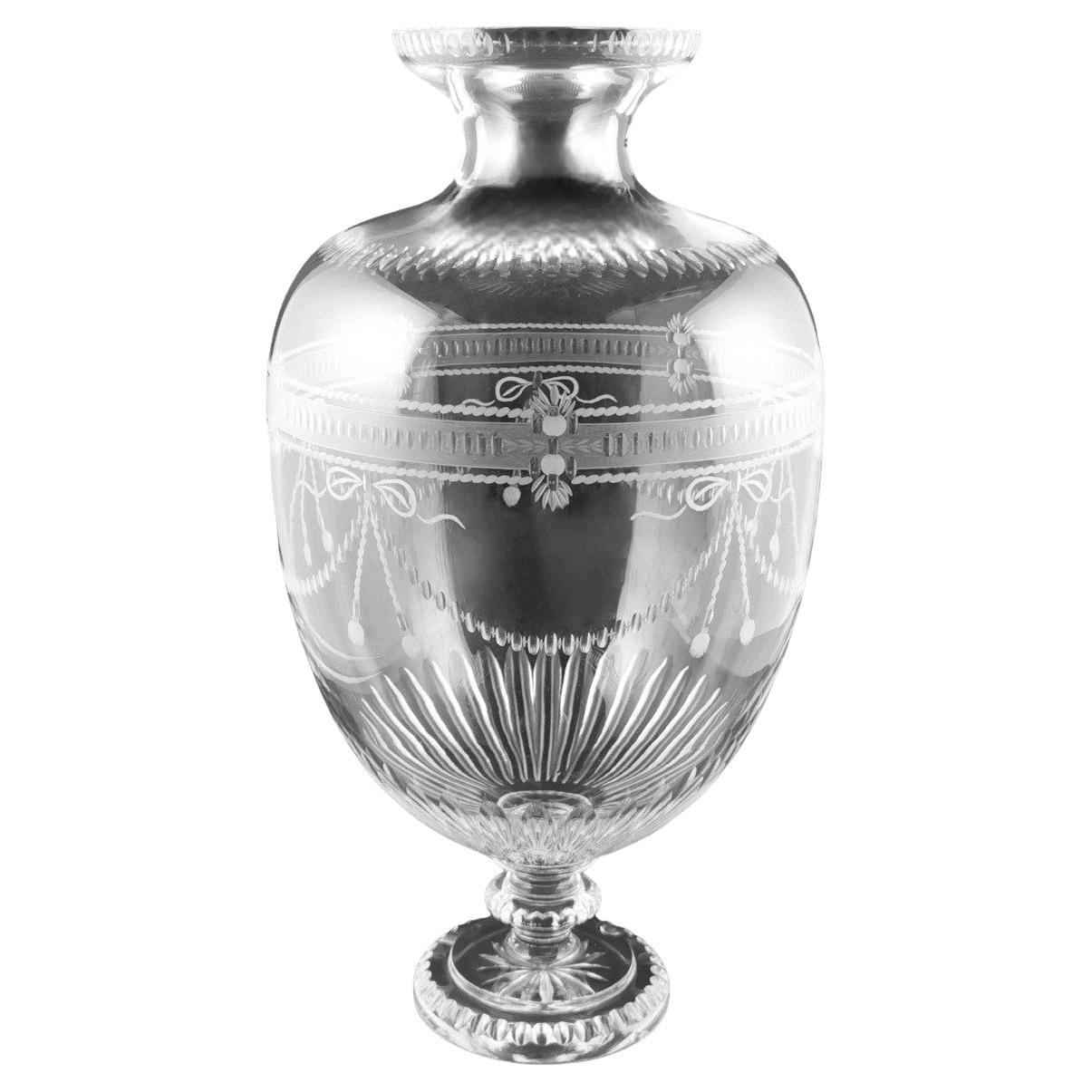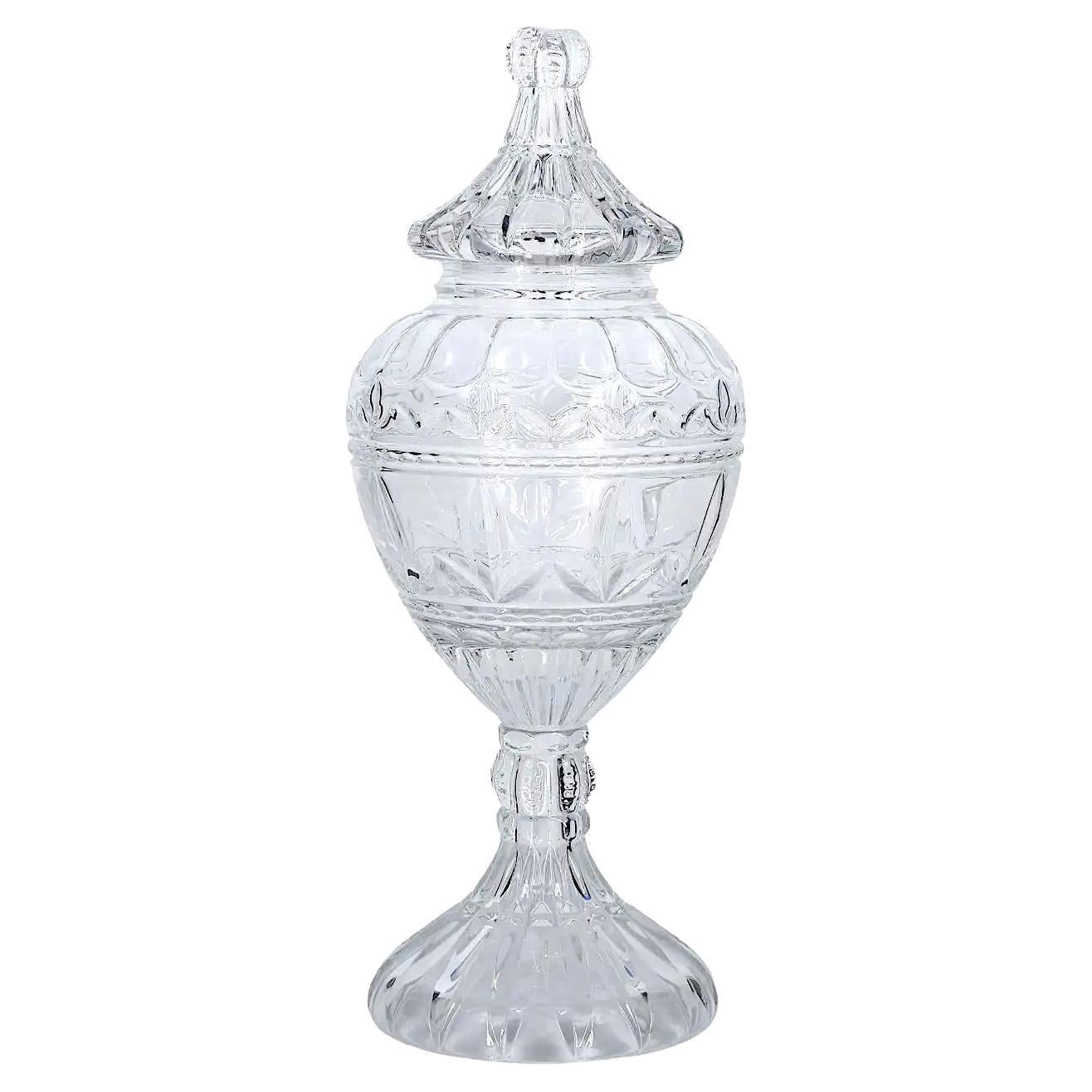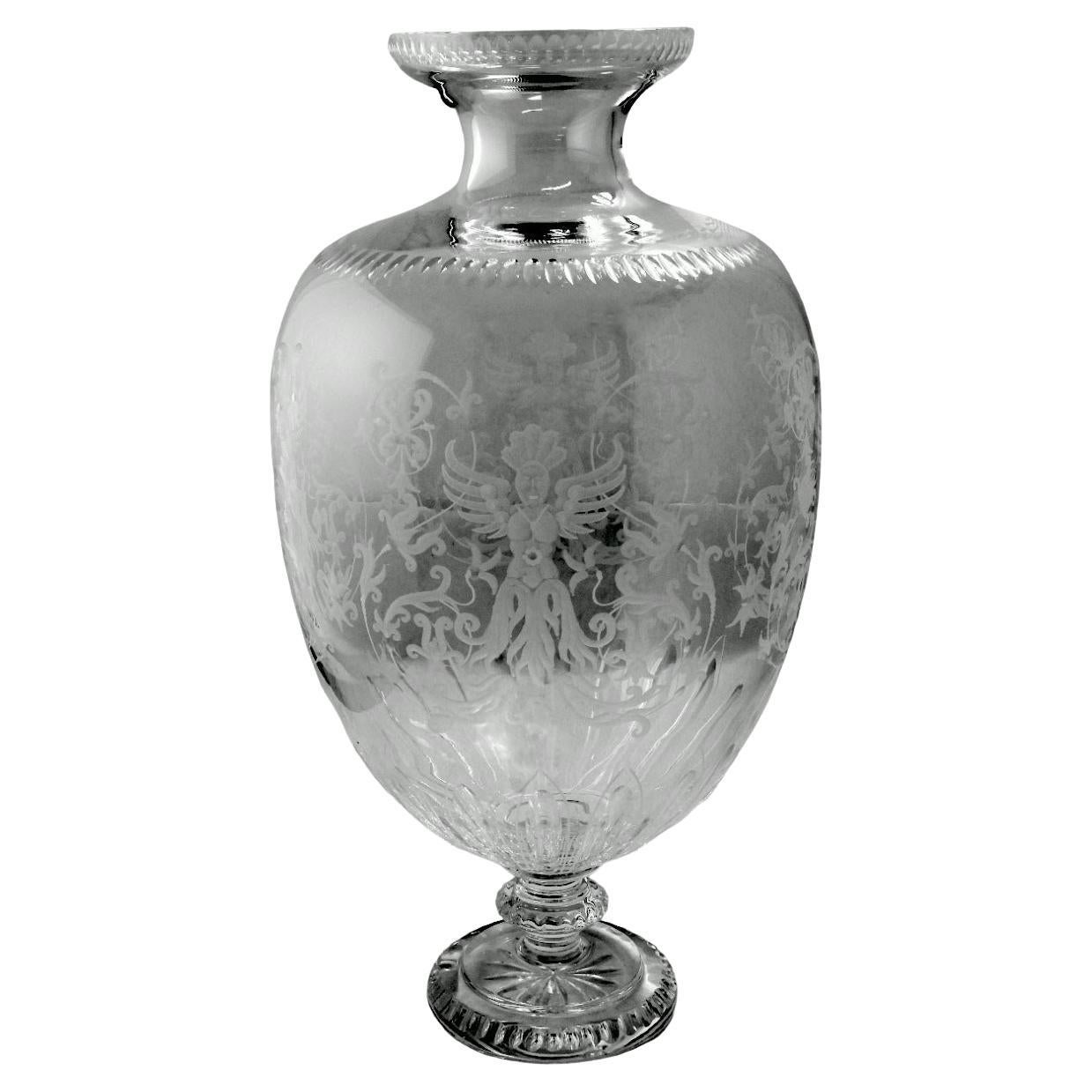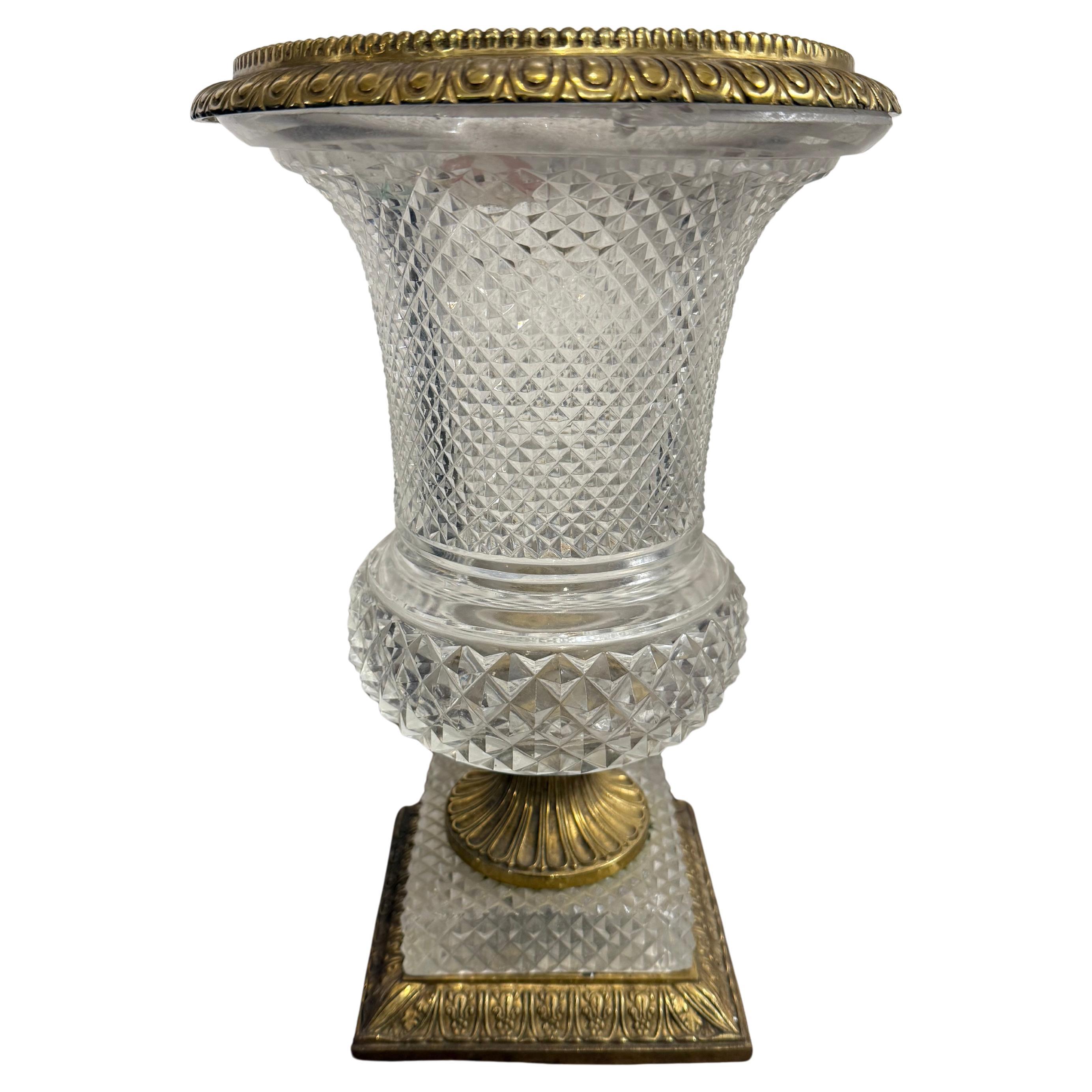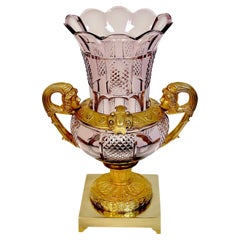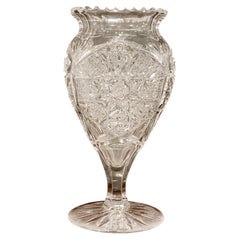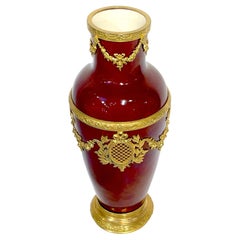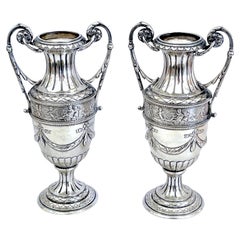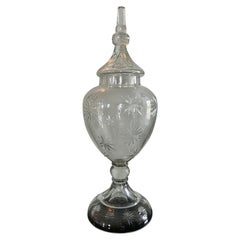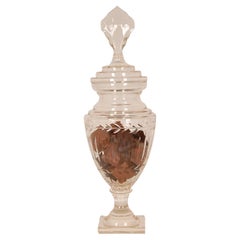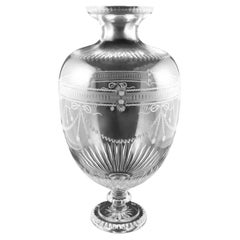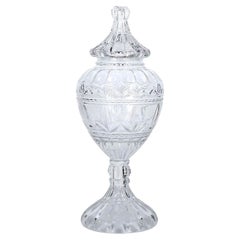Items Similar to Monumental Georgian Style Cut Glass Apothecary / Covered Urn 24" H
Want more images or videos?
Request additional images or videos from the seller
1 of 15
Monumental Georgian Style Cut Glass Apothecary / Covered Urn 24" H
$1,895per set
£1,426.76per set
€1,657.71per set
CA$2,668.18per set
A$2,972.55per set
CHF 1,559.44per set
MX$36,306.63per set
NOK 19,745.51per set
SEK 18,503.18per set
DKK 12,373.44per set
About the Item
Monumental Georgian-Style Cut Glass Apothecary/Covered Urn, 24" H
A striking and generously scaled cut glass apothecary/covered urn in the Georgian style, featuring exceptional clarity and detail throughout. Made in two pieces with a removable lid, Standing an impressive 24 inches tall overall, this monumental vessel is composed of two parts: a finely cut domed lid measuring 10 inches in diameter and 9 inches high, and a 15-inch tall urn with a 10.5-inch diameter, all raised on a solid 5-inch square pedestal base.
The urn is exquisitely executed with intricate diamond and crosshatch patterns skillfully hand-cut into its elegant baluster form. The lid features a fluted finial and flared profile, with beautifully coordinated cutting to match the body, culminating in a visually unified and refined presence. The stepped square foot adds architectural weight, balancing the gracefully swelling contours above.
A timeless decorative object that evokes the grandeur of 18th-century English glassmaking, this piece is ideal as a centerpiece on a large dining or console table or as a dramatic statement in a classical interior. In excellent condition, with felt pads affixed to the base for surface protection.
Dimensions: 24" high x 10.5" diameter overall; lid: 10" diameter x 9" high; base: 5" square
Consisting of two pieces are the lid and the base.
Overall Measurements
24" h x 10.5" diameter, raised on a 5" square base
The lid alone measures 10 in diameter x 9" high.
The base alone measures 10.5" in diameter x 15".
- Dimensions:Height: 24 in (60.96 cm)Diameter: 10.5 in (26.67 cm)
- Sold As:Set of 2
- Style:Georgian (In the Style Of)
- Materials and Techniques:Cut Glass,Polished
- Place of Origin:
- Period:
- Date of Manufacture:20th Century
- Condition:Wear consistent with age and use.
- Seller Location:West Palm Beach, FL
- Reference Number:Seller: T32251stDibs: LU2592345032932
About the Seller
5.0
Platinum Seller
Premium sellers with a 4.7+ rating and 24-hour response times
Established in 1996
1stDibs seller since 2017
1,409 sales on 1stDibs
Typical response time: <1 hour
- ShippingRetrieving quote...Shipping from: Highpoint , NC
- Return Policy
Authenticity Guarantee
In the unlikely event there’s an issue with an item’s authenticity, contact us within 1 year for a full refund. DetailsMoney-Back Guarantee
If your item is not as described, is damaged in transit, or does not arrive, contact us within 7 days for a full refund. Details24-Hour Cancellation
You have a 24-hour grace period in which to reconsider your purchase, with no questions asked.Vetted Professional Sellers
Our world-class sellers must adhere to strict standards for service and quality, maintaining the integrity of our listings.Price-Match Guarantee
If you find that a seller listed the same item for a lower price elsewhere, we’ll match it.Trusted Global Delivery
Our best-in-class carrier network provides specialized shipping options worldwide, including custom delivery.More From This Seller
View AllLarge 19th Century Russian Neoclassical Ormolu and Amethyst Cut Glass Vase
Located in West Palm Beach, FL
Large 19th-century Russian Neoclassical Ormolu and Amethyst Cut Glass Vase
St. Petersburg, mid-19th century
Offering a magnificent glimpse into 19th-century Russian Neoclassicism, ...
Category
Antique Mid-19th Century Russian Neoclassical Vases
Materials
Ormolu
$7,600 Sale Price
20% Off
American Brilliant Cut Glass Heart Shaped Vase, Rare Form
Located in West Palm Beach, FL
American brilliant cut glass heart shaped vase, rare form
Beautiful blank, raised on 4.5 inch diameter pedestal base, unmarked.
Category
Antique Late 19th Century American Vases
Materials
Cut Glass
$760 Sale Price
20% Off
Paul Milet for Sevres Red Flambe Ormolu Mounted Neoclassical Vase
By Manufacture Nationale de Sèvres
Located in West Palm Beach, FL
Paul Milet for Sevres Red Flambe Ormolu Mounted Neoclassical Vase
Designed by Paul Milet (1870-1950)
Executed by Sevres Porcelain
A beautiful Paul Milet for Sevres red flambe ormo...
Category
20th Century French Neoclassical Vases
Materials
Ormolu
$1,036 Sale Price
20% Off
Pair of 18th Century Italian Silver Neoclassical Vases, In the Louis XVI Style
Located in West Palm Beach, FL
Pair of 18th Century Italian Silver Neoclassical Vases, In the Louis XVI Style
Each vase Hallmarked
A rare and exquisite pair of 18th-century Italian Silver Neoclassical Vases, mad...
Category
Antique Late 18th Century Italian Louis XVI Vases
Materials
Sterling Silver
$5,400 Sale Price / set
20% Off
Diminutive Antique Sheffield Plate Armorial Tea/Cider Urn, Style Matthew Boulton
By Matthew Boulton
Located in West Palm Beach, FL
Diminutive Antique Sheffield Plate Armorial Tea/Cider Urn, Style Matthew Boulton, England, Circa 1800-1820
A Diminutive Antique Sheffield Plate Armorial Tea/Cider Urn from England, ...
Category
Antique Early 19th Century English Regency Sheffield and Silverplate
Materials
Sheffield Plate
$992 Sale Price
20% Off
English Art Deco Cut Glass Diminutive Decanter, Circa 1930s
Located in West Palm Beach, FL
English Art Deco Cut Glass Diminutive Decanter, Circa 1930s
Dimensions: 9" high x 3" diameter
Presenting a charming English Art Deco cut glass dim...
Category
20th Century English Art Deco Barware
Materials
Cut Glass
You May Also Like
Vintage Cut Glass or Crystal Lidded Urn
Located in W Allenhurst, NJ
Beautiful cut glass or crystal lidded urn. Deep faceted starburst design. Very large and heavy. Thick glass with great visual. Many starbursts throu...
Category
20th Century Unknown Neoclassical Revival Urns
Materials
Crystal
Victorian Sweetmeat Jar Cut Crystal Antique Footed Glass Urn Vase Jar Coupe
By Cristalleries De Baccarat, Saint Louis, Val Saint Lambert
Located in Wommelgem, VAN
French Victorian elegant cut crystal covered urn vase on square foot - sweetmeat jar
Style: Antique, Victorian, Neoclassical, Louis XVI, French
Baluster vase on a square foot and ste...
Category
Antique 19th Century French Victorian Jars
Materials
Crystal
Neoclassical Style Large Italian Crystal Vase with 18th Century Engravings
Located in Prato, Tuscany
Before describing the object under consideration, we must make an important clarification; the artifact, one of many that we will publish over time, is part of the museum collection of a historic Florentine crystal grinder that unfortunately closed recently. It is the Marcello Galgani & Son company, whose completely manual and artisanal work has not withstood the disproportionate advance of mass-produced mechanical processes! Marcello Galgani began his craft as a grinder and restorer in 1960; as the years went by, Marcello mastered and became familiar with particular techniques and shapes, resulting in the production of objects that manage to retain the freshness of grinding and engraving, the warmth and softness of light, and the inimitable flavor of unique artifacts. After several years, his son Lorenzo, who grew up among crystals, also entered the business and immediately became passionate about this ancient craft with skill and ability. Stimulated by the aesthetic sense of the past, father and son, set up a workshop in which the shapes they researched and created themselves are mouth-blown by traditional Tuscan glassmakers in Empoli, then ground and engraved using ancient sixteenth-century techniques, with motifs born from the Galgani's inexhaustible imagination or culturally inspired by designs of objects seen and studied in Florentine museums (Uffizi, Galleria Palatina, Museo degli Argenti, etc.). Marcello and Lorenzo Galgani were also Masters in the difficult art of restoration, bringing rare and precious objects back to life. As mentioned the company recently closed and disposed of all its last production, and only Marcello's old private museum collection remained, which includes unique and special objects created over time, a collection that the craftsman made available to us for a planned sale. All of the objects were made entirely by hand with old grinding wheels, but there were mainly two tools that allowed the creation of masterpieces: the right hand and the left hand of the master craftsman. Ancient glassmaking techniques were used for all the ground and engraved products: first, the object was ground with an emery wheel fed continuously by a jet of abrasive sand and water, then re-polished with a very fine-grained sandstone wheel also fed with water; the engravings were done freehand using as many as 10-15 small stone wheels for each design (flowers, branches, animals, etc. ); then the object was polished and shined; we must make, at this point, an important clarification on these last two operations: towards the end of the 1960s acid crystal polishing was devised, the object was immersed and rotated in a solution of sulfuric acid, fluoridic acid and water and in a short time all the defects left by the previous processes were eliminated, it was a fast, industrial operation that allowed to lower costs considerably, with discrete but not excellent results. But for Galgani's products polishing is done with a cork bark wheel wet with water and pumice, to make the surfaces more transparent, and finally polishing was achieved with a felt wheel wet with a paste of water, iron oxide, and cerium oxide. This series of processes takes an average of two days of work( sometimes much longer) for each object, each engraving or grinding is the result of the creative inventiveness of the two artisans, inventiveness that transforms crystal into reality material of the highest aesthetic value and inestimable value. All the items in the entire collection have never been used; they were part of the exhibition. Large crystal vase with base; the decorations, graceful and delicate, are in Neoclassical style. The object is "one-of-a-kind" signed by the Master; it was created in Marcello Galgani's workshop in 1981 and made with the techniques (grinding, engraving, and polishing) we explained in the description; for the shape, the Master was inspired by a vase found in a painting, preserved in the Uffizi Gallery in Florence by the 16th-century painter Jacopo Ligozzi...
Category
Late 20th Century Italian Neoclassical Vases
Materials
Crystal
French Cut Crystal Tall Covered Decorative Piece / Urn
Located in Tarry Town, NY
French cut crystal tall covered decorative piece / urn. The piece features and exterior cut crystal design details resting on a round form pedestal base. The piece is in great condit...
Category
Late 20th Century French Urns
Materials
Crystal
Baroque Style Large Italian Crystal Vase With Grotesque Engravings
Located in Prato, Tuscany
Before describing the object under consideration, we must make an important clarification; the artifact, one of many that we will publish over time, is part of the museum collection of a historic Florentine crystal grinder that unfortunately closed recently. It is the Marcello Galgani & Son company, whose completely manual and artisanal work has not withstood the disproportionate advance of mass-produced mechanical processes! Marcello Galgani began his craft as a grinder and restorer in 1960; as the years went by, Marcello mastered and became familiar with particular techniques and shapes, resulting in the production of objects that manage to retain the freshness of grinding and engraving, the warmth and softness of light, and the inimitable flavor of unique artifacts. After several years, his son Lorenzo, who grew up among crystals, also entered the business and immediately became passionate about this ancient craft with skill and ability. Stimulated by the aesthetic sense of the past, father and son, set up a workshop in which the shapes they researched and created themselves are mouth-blown by traditional Tuscan glassmakers in Empoli, then ground and engraved using ancient sixteenth-century techniques, with motifs born from the Galgani's inexhaustible imagination or culturally inspired by designs of objects seen and studied in Florentine museums (Uffizi, Galleria Palatina, Museo degli Argenti, etc.). Marcello and Lorenzo Galgani were also Masters in the difficult art of restoration, bringing rare and precious objects back to life. As mentioned the company recently closed and disposed of all its last production, and only Marcello's old private museum collection remained, which includes unique and special objects created over time, a collection that the craftsman made available to us for a planned sale. All of the objects were made entirely by hand with old grinding wheels, but there were mainly two tools that allowed the creation of masterpieces: the right hand and the left hand of the master craftsman. Ancient glassmaking techniques were used for all the ground and engraved products: first, the object was ground with an emery wheel fed continuously by a jet of abrasive sand and water, then re-polished with a very fine-grained sandstone wheel also fed with water; the engravings were done freehand using as many as 10-15 small stone wheels for each design (flowers, branches, animals, etc. ); then the object was polished and shined; we must make, at this point, an important clarification on these last two operations: towards the end of the 1960s acid crystal polishing was devised, the object was immersed and rotated in a solution of sulfuric acid, fluoridic acid and water and in a short time all the defects left by the previous processes were eliminated, it was a fast, industrial operation that allowed to lower costs considerably, with discrete but not excellent results. But for Galgani's products polishing is done with a cork bark wheel wet with water and pumice, to make the surfaces more transparent, and finally polishing was achieved with a felt wheel wet with a paste of water, iron oxide, and cerium oxide. This series of processes takes an average of two days of work( sometimes much longer) for each object, each engraving or grinding is the result of the creative inventiveness of the two artisans, inventiveness that transforms crystal into reality material of the highest aesthetic value and inestimable value. All the items in the entire collection have never been used; they were part of the exhibition. Large crystal vase; the decorations, in baroque style represent a series of "grotesques" The object is "a unique piece" signed by the Master, it was created in Marcello Galgani's workshop in 1983 and made with the techniques (grinding, engraving and polishing) that we explained in the description; for the shape, the Master was inspired by a vase present in a painting, preserved in the Uffizi Gallery in Florence by the sixteenth-century painter Jacopo Ligozzi...
Category
Late 20th Century Italian Baroque Vases
Materials
Crystal
A French Empire Style Cut-Glass and Bronze d’Oré Urn, 19th Century
Located in ARMADALE, VIC
A French Empire Style Cut-Glass and Bronze d’Oré Urn, 19th Century
Provenance: Private Australian Collection.
Description:
The cut glass urn flaring to an everted ormolu lip with ...
Category
Antique 19th Century French Empire Urns
Materials
Bronze, Ormolu
More Ways To Browse
Urn Base Table
Urns On Pedestals
Monumental Glass Vase
Glass Urn Vases
English Style Vase
Large Glass Urns
Georgian Cut Glass
Urn Pedestal Table
Baluster Glass Vase
Vintage Square Glass Vase
Lidded Glass Urns
Urn Pedestal Dining Tables
Glass Covered Urns
24 Inch Vase
Large Urn On Pedestal
Vintage Fluted Glass Vase
Large Glass Vase Urn
Pad Foot Table
